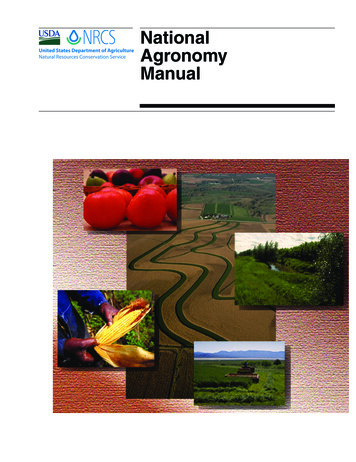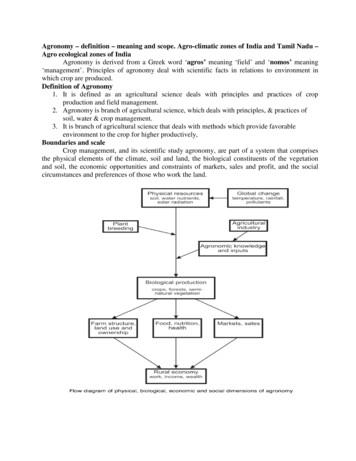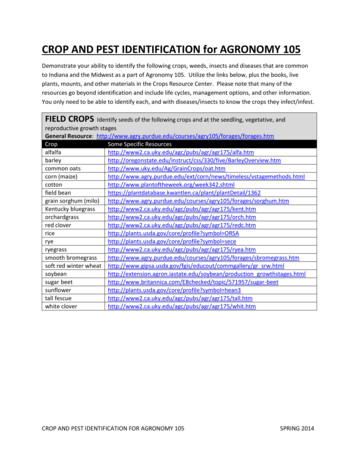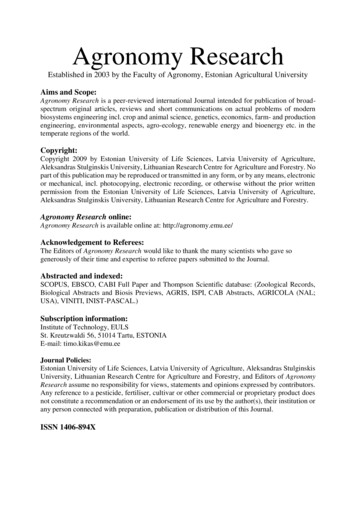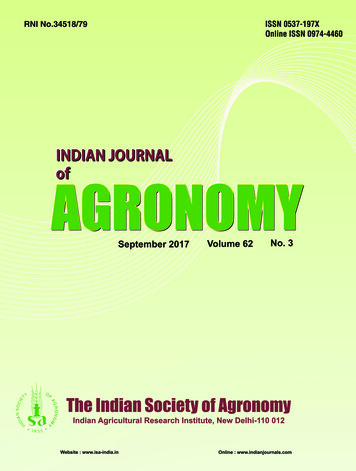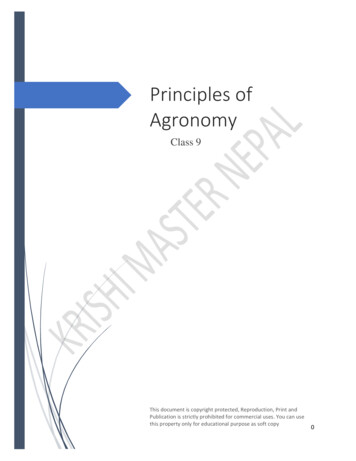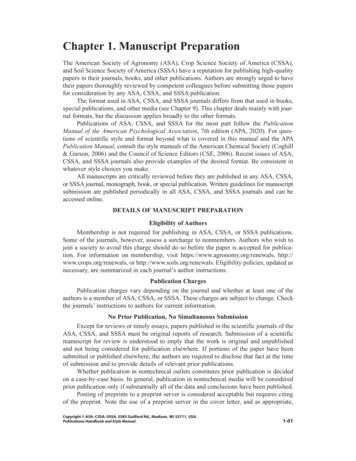
Transcription
Chapter 1. Manuscript PreparationThe American Society of Agronomy (ASA), Crop Science Society of America (CSSA),and Soil Science Society of America (SSSA) have a reputation for publishing high-qualitypapers in their journals, books, and other publications. Authors are strongly urged to havetheir papers thoroughly reviewed by competent colleagues before submitting those papersfor consideration by any ASA, CSSA, and SSSA publication.The format used in ASA, CSSA, and SSSA journals differs from that used in books,special publications, and other media (see Chapter 9). This chapter deals mainly with journal formats, but the discussion applies broadly to the other formats.Publications of ASA, CSSA, and SSSA for the most part follow the PublicationManual of the American Psychological Association, 7th edition (APA, 2020). For questions of scientific style and format beyond what is covered in this manual and the APAPublication Manual, consult the style manuals of the American Chemical Society (Coghill& Garson, 2006) and the Council of Science Editors (CSE, 2006). Recent issues of ASA,CSSA, and SSSA journals also provide examples of the desired format. Be consistent inwhatever style choices you make.All manuscripts are critically reviewed before they are published in any ASA, CSSA,or SSSA journal, monograph, book, or special publication. Written guidelines for manuscriptsubmission are published periodically in all ASA, CSSA, and SSSA journals and can beaccessed online.DETAILS OF MANUSCRIPT PREPARATIONEligibility of AuthorsMembership is not required for publishing in ASA, CSSA, or SSSA publications.Some of the journals, however, assess a surcharge to nonmembers. Authors who wish tojoin a society to avoid this charge should do so before the paper is accepted for publication. For information on membership, visit https://www.agronomy.org/renewals, http://www.crops.org/renewals, or http://www.soils.org/renewals. Eligibility policies, updated asnecessary, are summarized in each journal’s author instructions.Publication ChargesPublication charges vary depending on the journal and whether at least one of theauthors is a member of ASA, CSSA, or SSSA. These charges are subject to change. Checkthe journals’ instructions to authors for current information.No Prior Publication, No Simultaneous SubmissionExcept for reviews or timely essays, papers published in the scientific journals of theASA, CSSA, and SSSA must be original reports of research. Submission of a scientificmanuscript for review is understood to imply that the work is original and unpublishedand not being considered for publication elsewhere. If portions of the paper have beensubmitted or published elsewhere, the authors are required to disclose that fact at the timeof submission and to provide details of relevant prior publications.Whether publication in nontechnical outlets constitutes prior publication is decidedon a case-by-case basis. In general, publication in nontechnical media will be consideredprior publication only if substantially all of the data and conclusions have been published.Posting of preprints to a preprint server is considered acceptable but requires citingof the preprint. Note the use of a preprint server in the cover letter, and as appropriate,Copyright ASA–CSSA–SSSA, 5585 Guilford Rd., Madison, WI 53711, USA.Publications Handbook and Style Manual.1-01
state how the manuscript has been adjusted/updated between the preprint version and theversion submitted to the journal. Failure to alert the journal in your cover letter to any priorpublication of your submission may be viewed as an ethical violation.Manuscript HandlingManuscripts are handled by similar, but not identical, procedures in ASA, CSSA,and SSSA journals. The basic policy is that at least two independent scientists must agreebefore a paper is accepted for publication or released back to the author (rejected). Releaseof a paper by a journal does not preclude its resubmission to that same or another ASA,CSSA, SSSA journal after its weaknesses have been eliminated. For example, a paperreleased because it needed another year of data may be resubmitted after those data havebeen gathered and the results incorporated into the paper. Such a resubmission must beaccompanied by a copy of the original release letter. A manuscript may be released beforereview, either because it does not conform to acceptable standards or because the subjectmatter is outside the scope of the journal.Manuscript SubmissionManuscripts are submitted via the journal’s online manuscript submission system.Consult the instructions to authors for details.Receipt of manuscripts will be acknowledged. Communication from editorial boardmembers and the editing staff at headquarters is usually with the corresponding authoronly; normally the submitting author is the corresponding author (see Authorship, below).The cover letter or title page should give the corresponding author’s current phone numberand email address for use during review and production.Occasionally, a journal editor may determine that the submitted paper’s subject matter is more suitable for a different society journal. In those cases, the editor will releasethe paper before review and contact the corresponding author regarding the possibility ofa transfer.Manuscript ProcessingUpon receipt, each paper is assigned a unique manuscript number that identifies boththe manuscript and the publication. A typical journal manuscript number is in the formX-NNNN-MM-nnnn, where X is a group of letters identifying the journal, NNNN identifiesthe year, MM identifies the month, and nnnn is the number of the particular manuscript(e.g., jeq-2019-02-0042 is the 42nd manuscript submission received for the Journal ofEnvironmental Quality in 2019). This number is communicated to the corresponding authoralong with acknowledgment of receipt. Refer to the manuscript number in all subsequentcommunications. Authors will be informed (and usually asked for additional input) as themanuscript moves through the various steps involved in review, acceptance or release, andproduction. (See also Chapter 8.)After a manuscript has been accepted for publication by the designated scientistmember of the editorial board, it will be edited for style and grammar and prepared forpublication by the headquarters editorial staff.Anonymous ReviewAll papers submitted to ASA, CSSA, SSSA journals are given an anonymousreview—meaning that the names of reviewers are not revealed to the authors of the papersor to the other reviewers.1-02Copyright ASA–CSSA–SSSA, 5585 Guilford Rd., Madison, WI 53711, USA.Publications Handbook and Style Manual.
Most ASA, CSSA, and SSSA journals use a single-blind review process, wherethe authors do not know the names of the reviewers. Some of our journals use a doubleblind process and also withhold the names of the authors from the reviewers. Check theindividual journal's instructions to authors for details on the review process. For journalsthat use a double-blind process, prepare the manuscript with no identifying information(e.g., no byline, addresses/ affiliations, acknowledgments, etc.; these will be added after amanuscript has been accepted). Take care to label tables and figures with reference to thepaper’s title, not author names. Any identification in headers or footers should be similarlyanonymous. Authorship may also be unintentionally revealed through such software features as document summaries. If this is a concern, consult your local software experts.When authors submit a manuscript via the online manuscript submission system,they will be asked to enter contact information into the system database, and the editorswill have access to this information so that they can contact the authors about the outcomeof the review.SUBMISSION SPECIFICSAll accepted manuscript files will be edited in Microsoft Word. Therefore, authorsare encouraged to compose manuscripts in Microsoft Word. The manuscript must bedouble-spaced, with continuous line numbering.Do not use complicated fonts and features available in Microsoft Word. Limited useof italics, bold, and superscripts and subscripts is acceptable.Do not use such word-processing features as automatic footnoting and outlining.These features interfere with both electronic editing and typesetting. If you need to placea numbered list in your manuscript, enter the numbers and use appropriate tabs and indentsmanually instead of using automatic outlining.Headings and SubheadingsHeadings guide the reader, but too many headings can be distracting. Keepheadings short. Abbreviations are allowed in Level 2, 3, and 4 headings.Differentiate between the heading levels in your manuscript. For style, examine recentissues of the publication to which the manuscript will be submitted. In most ASA, CSSA,and SSSA journals, Level 1 headings (the main headings) are used for the main sections,such as Introduction, Materials and Methods, Results, and Discussion, with Level 2 headingsused for subsections. Level 3 and Level 4 headings are allowed, but use them sparingly.TYPES OF JOURNAL ARTICLESThe most common type of paper to appear in ASA, CSSA, and SSSA journals is thestandard research paper. The journals also publish other paper types. Consult the instructions to authors of each journal for a description of all current types of papers.Review PapersReview papers are usually less formal than full-length articles. Such papers shouldprovide a synthesis of existing knowledge and give new insights or concepts not previously presented in the literature, or at least not with the same level of detail.These articles should not be considered exhaustive reviews of the literature (as perAnnual Review of Plant Physiology and Molecular Biology) but should include enoughliterature review to provide a basis for understanding and interpretation of the topicunder consideration.Copyright ASA–CSSA–SSSA, 5585 Guilford Rd., Madison, WI 53711, USA.Publications Handbook and Style Manual.1-03
A good review is often one of the most important ways to advance an area of science.Readers expect a review paper to deal with an important subject that needs a scholarly review, cover the entire spectrum of the subject, not just the segment about which theauthor of the review paper has published articles, present a balanced coverage that is fair to all the work it reviews, and add a perspective to the entire subject and contribute significantly to understanding.Issue PapersThe intent of these papers is to stimulate discussion and possibly a rethinking of current views. They may be provocative and controversial. Our journals use different headings for such appers, such as "Perspectives," "Forum" papers, or "Environmental Issues."Check the individual journal's online About pages for details.Notes and Short CommunicationsNotes and Short Communications represent a separate category of scientific manuscripts. Papers in this category typically describe research techniques, apparatus, andobservations. Observations usually are limited to studies and reports of unrepeatablephenomena or other unique circumstances. These articles are usually shorter than researchpapers, normally occupying four or fewer printed pages in the journal.Occasionally, an editor may determine that a paper submitted as a research paper willbetter fit this category, or vice versa. If the author agrees, the manuscript can be transferredto or from this category of papers.The review procedure for these papers is identical to that for research papers.Letters to the EditorAll our journals publish Letters to the Editor. Letters may contain comments on articlesappearing in the journals or general discussions about agronomic research and are limited toone printed page. Letters must be approved by the editor and may be peer reviewed. If a letterdiscusses a published paper, the author of that paper will be invited to submit a response to thecomments; typically, the response is published along with the letter.Core IdeasAt submission, most journals ask authors to to prepare three to five core ideas (up to115 characters each, spaces included), which will appear with the accepted article and onthe journal's table of contents.Research PapersManuscripts of research papers prepared for ASA, CSSA, and SSSA journals arenormally arranged in the following order:1. Title and byline2. Core Ideas3. Author–paper documentation (addresses/affiliations, email address of the corresponding author, etc.—see below)4. Abstract5. Abbreviations6. Introduction (including literature review)7. Materials and Methods8. Results. This section is sometimes combined with the discussion section1-04Copyright ASA–CSSA–SSSA, 5585 Guilford Rd., Madison, WI 53711, USA.Publications Handbook and Style Manual.
9. Discussion. No separate summary section is used because it would duplicate the function of the abstract; a summary statement may, however, be given as a closing paragraph.10. Conclusions (optional; this may be a titled section or part of the discussion section)11. Data Availability statement (optional)12. Acknowledgments (optional)13. Author Contributions (this is generated from metadata provided during submission)14. Conflict of Interest statement15. References16. Figure captions and tables should be placed in the main text close to where they arefirst called out for submitted manuscripts. For accepted manuscripts, figure captionsand tables appear after the reference list, and figures should be submitted as separatehigh-resolution image files in the following acceptable formats: EPS, TIF, PDF, or JPG.For journals with a double-blind review process, the byline, author–paper documentation,and acknowledgments should not be included at the time of submission to ensure anonymity—authors will be asked to add these items once the paper has been accepted.Sometimes a Theory section substitutes for or precedes Materials and Methods. Anysection may include subheadings to guide the reader through significantly different aspectsof the topic.Manuscript FormatTitle. The title should represent the article’s content and facilitate retrieval in indexesdeveloped by secondary literature services. The terms in the title should be limited to thosewords that give significant information about the article’s content. It is best to start thetitle with key words—not with words such as "Effect of" or "Influence of." Many readersperuse titles in a journal’s table of contents to decide whether to read a given paper. A goodtitle briefly identifies the subject, indicates the purpose of the study, and introduces keyterms or concepts. The recommended limit is 12 words.Keep titles free of nonstandard abbreviations, chemical formulas, or proprietary names,and avoid unusual or outdated terminology. Use common names of crops and chemicals. If acrop or microorganism has no common name or if the common name is in dispute, then thescientific name (with authority) may be used in the title.Series titles are used infrequently in ASA, CSSA, SSSA journals. An author contemplating a series of articles on the same subject should refer to the journal's current editorialpolicy. Articles in a series are not discouraged as such, but the editors need to be assuredthat all papers in the series are available for review and that the reader will be able toobtain earlier and later material in that series.Titles may be descriptive (e.g., Variables A and B under C Conditions), declarative (A Relates to B in C Manner), or even a question (Does A Do X?). Examples:Soil-Water and Root Dynamics under Hedgerow Intercropping in Semiarid Kenya(Govindarajan et al., Agronomy Journal, 88:513–520); Clipping Foliage DifferentiallyAffects Phytosiderophore Release by Two Wheat Cultivars (Hansen et al., AgronomyJournal, 87:1060–1063); Is Soil Temperature Better Than Air Temperature for PredictingWinter Wheat Phenology? (McMaster and Wilhelm, Agronomy Journal, 90, 602–607).Authorship. (Added at acceptance for double-blind journals.) We encourage the useof full names in bylines (e.g., Morgan L. Jones or M. Louise Jones instead of M. L. Jones).The first person listed in the title is, by definition, the senior author; the correspondingauthor deals with proofs and, after publication, with reprint requests. The authors of theCopyright ASA–CSSA–SSSA, 5585 Guilford Rd., Madison, WI 53711, USA.Publications Handbook and Style Manual.1-05
paper decide the sequence of author names; the order should be agreed upon by all authorsinvolved.Author–Paper Documentation. (Added at acceptance for double-blind journals.) Theauthor–paper documentation appears on the first page of the published article. The purposeis to give addresses for all authors and an email address for the corresponding author (authordocumentation), as well as the date the paper was received for review, the date the paper wasaccepted, and any necessary institutional identification such as a grant support, dissertationrequirement, or a journal article number (the paper documentation). In the manuscript, putthis paragraph after the byline, on the cover page only. Alternatively, any necessary institutional identification can be placed in the Acknowledgments section.If all authors are at one address, do not repeat the names in the documentation. Otherwise,group together all authors at a single address in the order they appear in the byline. Do notinclude professional titles. Following complete addresses for all authors, give any sponsoringinstitutional information, with brief addresses; and lastly “Corresponding author” immediatelyfollowed by corresponding author's email address in parentheses. Example:Neha Kothari, B. Todd Campbell, Jane K. Dever, and Lori L. HinzeN. Kothari and J.K. Dever, Texas A&M AgriLife Research, 1102 East FM 1294, Lubbock, TX 79403, USA; B.T.Campbell, USDA-ARS, 2611 W. Lucas St., Florence, SC 29501, USA; L.L. Hinze, USDA-ARS, 2881 F&B Rd.,College Station, TX 77845, USA. Corresponding author (lori.hinze@ars.usda.gov).If an author has moved, the current address can be added, but if the previous address is afunder, then it should not be removed. The address where the work was done should gofirst; the current address normally goes at the end (except SSSAJ):A. Smith and B. Jones, Univ. of Illinois, 1102 S., Goodwin Ave., Urbana, IL, 61801, USA; A. Smith, currentaddress: Purdue Univ., West Lafayette, IN 47907, USA.Acknowledgment of grant funding, support information, and personal thanks belong in theacknowledgments section at the end of the paper. Any required government or institutionaldisclaimer in reference to commercial products or trade names mentioned in the text shouldalso be placed in the acknowledgments section.Footnotes. Footnotes are not allowed.Abstract. A journal abstract has two typical uses. Printed at the head of a scientificpaper, an abstract helps readers decide whether to delve into the paper; abstracts are alsopublished via abstracting and indexing services. Because the abstract will be seen and readby many more people than will read the paper, everything that is important in the papermust be reflected in the abstract. The abstract should call attention to new techniques,observations, or data. Be specific.In essence, an informative abstract (also called a substantive abstract) presents thepaper in miniature, complete within itself. It moves from an introductory statement of therationale and objectives or hypotheses, through materials and methods, to the results andconclusions. (A descriptive abstract is more like a table of contents for the paper and israrely used in scientific publications except, perhaps, for review or opinion papers.) Anumber of books and articles offer useful advice on preparing abstracts (e.g., O’Connor& Woodford, 1976; O’Connor, 1979; Day, 1988), and an Internet search for “informativeabstract” is likely to have recent course materials on scientific writing among the results.1-06Copyright ASA–CSSA–SSSA, 5585 Guilford Rd., Madison, WI 53711, USA.Publications Handbook and Style Manual.
Because an informative abstract has to stand alone, do not deflect the reader withphrases such as "will be discussed" or "will be explained." For the same reason, do notinclude reference, figure, or table citations. Equations also are inappropriate in an abstractunless they are the central finding of the study. Limit your use of abbreviations, and definethe ones you do use.At first mention in the abstract, give the complete scientific name (with authority)for plants. The scientific names of plants should be repeated at the first mention in themain text. In the main text, give scientific names of other organisms, including causalagents of diseases. The scientific names for larger animals (e.g., sheep) do not need to begiven unless germane to the article and/or there may be confusion as to what animal isbeing discussed. Complete soil series descriptions should be provided upon first mentionin the main text; they do not need to be given in the abstract. Using the common names ofchemicals is acceptable. The full names of chemicals can be provided at first mention inthe main text if germane to the article.Write the abstract as a single paragraph, with a limit of 250 words ( 1,500 characters) for full-length papers and 150 words ( 900 characters) for notes. Some abstractingservices truncate text beyond a certain length; what is lost is most likely the conclusions.Reproduced below (with permission of the author) is a published abstract with its structure labeled. This example shows both the overall construction of the abstract and the contentsof its parts. (From Agronomy Journal, 78, 720–726 [1986], updated to conform to new styleguidelines.)Introduction. Use the introduction to review published literature and issues relatedto your topic. A thorough introduction helps the reader recognize what your researchcontributes to the current knowledge in your subject area. Begin your article by clearlyidentifying its subject, and state the hypothesis or definition of the problem the researchwas designed to solve. To orient readers, give a brief reference to previous concepts andresearch. Limit literature references to essential information, and do not rely on old references when newer ones are available.Keep the introduction short, but include (a) a brief statement of the problem that justifies doing the work, or the hypothesis on which it is based; (b) the findings of others thatwill be further developed or challenged; and (c) an explanation of the general approachand objectives. This last part may indicate the means by which the question was examined,especially if the methods are new.Abbreviations and acronyms defined in the abstract should also be defined in themain body of the text.Materials and Methods. In the Materials and Methods section, give enough detailto allow a competent scientist to repeat the experiments, mentally or in fact.In the materials section, describe the preparation method, equipment, and measurements, using SI-acceptable units. Not all materials need to be identified by brand nameand manufacturer. Consider first whether the particular product is essential to the outcomeof the research, and then how readily available that particular product might be to otherresearchers. For example, if any standard test tube will work, it is not necessary to statethe manufacturer of the tubes you used. If, however, the test tube must be lined with Teflonor be made of Pyrex (or in any other way differ from standard), then say so and, if such atest tube is not readily available, tell where it can be obtained.When a product must be identified by trade name, add the name of the manufactureror a major distributor parenthetically after the first mention of the product. Example: “SoilCopyright ASA–CSSA–SSSA, 5585 Guilford Rd., Madison, WI 53711, USA.Publications Handbook and Style Manual.1-07
Dryland Grain Sorghum Water Use, Light Interception,and Growth Responses to Planting GeometryJ. L. SteinerABSTRACTRationaleObjectives orhypothesisMethodsResultsConclusionsCrop yields are primarily water-limited under dryland production systems in semiaridregions.This studywas conducted to determine whether the growing-season waterbalance could be manipulated through planting geometry.The effects of row spacing, row direction, and plant population on the water use, lightinterception, and growth of grain sorghum [Sorghum bicolor (L.) Moench] were investigated at Bushland, TX, on a Pullman clay loam (fine, mixed, superactive thermic TorrerticPaleustoll).In 1983, which had a dry growing season, narrow-row spacing and higher populationincreased seasonal evapotranspiration (ET) by 7 and 9%, respectively, and shifted thepartitioning of ET to the vegetative period. Medium population crops yielded 6.2 and2.3 Mg ha–1 of dry matter and grain, respectively. High population resulted in high drymatter (6.1 Mg ha–1) and low grain yield (1.6 Mg ha–1), whereas low population resultedin low dry matter (5.4 Mg ha–1) and high grain yield (2.3 Mg ha–1). Row direction did notaffect water use or yield. In 1984, dry matter production for a given amount of ET and lightinterception was higher in the narrow-row crops. Evapotranspiration was less for a givenamount of light interception in the narrow-row crops and in the north–south row crops.Narrow-row planting geometry appears to increase the partitioning of ET to the transpiration component and may improve the efficiency of dryland cropping systems.respiration was measured with a CO2 analyzer (Model LI-6251, LI-COR).” If the particular product is both essential to the research and no longer commercially available, describea suitable substitute and its source.In the case of specially procured or proprietary materials, give the pertinent chemicaland physical properties (e.g., purity, pH, concentration). Chemical rather than trade namesare preferred. Example: “Reference Suwannee River fulvic acid (IHSS-FA) and humicacid (IHSS-HA) were purchased from the International Humic Substance Society (IHSS).”Plants and other organisms, including viruses, insects, bacteria, and pathogens should beidentified accurately at first mention by scientific name (with authority for plants) and cultivarname if applicable. Scientific names for larger animals (e.g., sheep) should be given if relevantto the article and/or there may be confusion as to what animal is being discussed. Identify soilsby great group name at least and preferably by soil series name and description.Cite references for your methods and reference the edition you used. If the techniquesare widely familiar, use only their names. If a method is modified, outline the modificationor cite a reference, unless the modification is trivial. Give details of unusual experimentaldesigns or statistical methods.The Materials and Methods section may be arranged chronologically, by a successionof techniques, or in any other logical manner, such as by experiment or location, and mayinclude tables and figures.Results. Use tables, graphs, and other illustrations in the Results section to providethe reader with a clear understanding of representative data obtained from the experiments.Call attention to significant findings and special features (e.g., one quantity is greater thananother, one result is linear across a range, or a particular value is optimum), but do notrepeat in detailed prose what is already clear from an examination of the graphics.1-08Copyright ASA–CSSA–SSSA, 5585 Guilford Rd., Madison, WI 53711, USA.Publications Handbook and Style Manual.
If you have minimal results, describe them in the text. You may want to summarizemore complicated results in tables or figures.If you do not have a separate Discussion section, relate the results to your objectivesand to each other.Discussion. Use the Discussion section to interpret your results. Give particularattention to the problem, question, or hypothesis presented in the introduction. A gooddiscussion typically covers most or all of the following steps:1. Relate the results to the original objectives.2. Explain the principles, relationships, and generalizations that can be supported bythe results.3. Address any exceptions or lack of correlation that qualify the findings, or difficulties that point to areas for further investigation.4. Explain how the results relate to previous findings, whether in support, contradiction, or simply as added data.5. Present conclusions, supported by a summary of the evidence.Whether combined with the Results section or standing alone, the Discussion sectionshould focus on the meaning of your findings, not recapitulate them.Scientific speculation is encouraged, but it should be reasonable, firmly foundedin observation, and subject to tests. It must also be identified as such. Where results differ from previous results for unexplained reasons, possible explanations should not belabored. Controversial issues should be discussed clearly and fairly.References. The References section lists only the literature cited in the paper.Authors are encouraged to cite only significant, published, and up-to-date references.Figure Captions, Tables, and Figures. In the submitted manuscript, tables and figures (review quality) with captions should be placed into the text document at first mention.Figures can also be submitted separately as image files in the following acceptable formats:EPS, TIF, PDF, or JPG.For accepted manuscripts, figure captions and tables appear after the reference list,and figures should be submitted as separate high-resolution image files in the followingacceptable formats: EPS, TIF, PDF, or JPG. No separate list of table titles is needed.Color figures of accepted manuscripts must adhere to our color policy (see Chapter5 and the online "ASA, CSSA, SSSA Editorial Policies" page for details). To maintainclear contrast, use line patterns instead of shading and avoid thin, light lines. As feasible,plan f
The American Society of Agronomy (ASA), Crop Science Society of America (CSSA), and Soil Science Society of America (SSSA) have a reputation for publishing high-quality papers in their journals, books, and other publications. Authors are strongly urged to have their papers thoroughly reviewed by competent colleagues before submitting those papers

